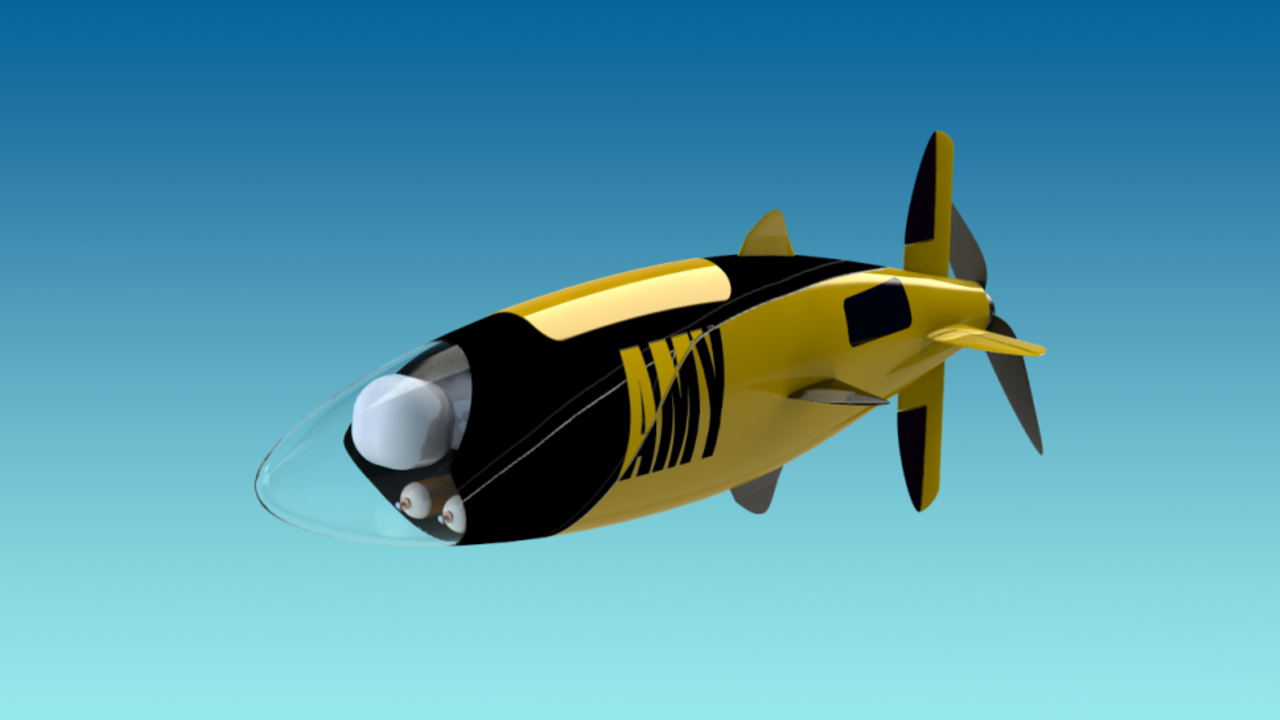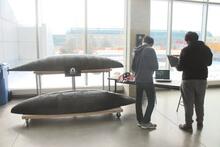
Submarine student team inspired by engineering innovation
Amy is the name of a submarine that recently competed in the third biennial European International Submarine Race (eISR) in Gosport, England

Amy is the name of a submarine that recently competed in the third biennial European International Submarine Race (eISR) in Gosport, England
By Shane Schick Faculty of EngineeringHer name is Amy, and even before she starts racing underwater, she’s already created a sea change in how a submarine student team at the University of Waterloo see the potential of engineering to pursue innovation.
Amy is not a person but the name of a submarine that recently competed in the third biennial European International Submarine Race (eISR) in Gosport, England in July. A single scuba diver will pilot the submarine and propel it through a slalom course.
WatSub, as the group behind the project is known, has been at work since November of 2014, growing from just a pair of students, Gonzalo Espinoza and Ojaswi Tagore, a much larger group carving out a niche for themselves.
“We all get inspired by the innovation that surrounds us at the university, and we want to be innovative as well,” says team member Ana Krstanovic. “Having this opportunity to work under water is so challenging, because the mechanics of underwater engineering is completely different.”
Whereas Waterloo engineering students might already be studying fluid dynamics, for example, creating the submarine draws upon everything from electrical engineering to mechatronics. After figuring out the basic structure and recruiting students, a big part of the project involved research into all the potential materials involved in submarine design.
“What we focused on first is looking at what has been done already – the manuals of the competition, and design reports of the participants,” Krstanovic says, a process which included not only what the team will be up against in England but a similar competition in Maryland which takes place every two years. “We went to the competition as observers and got to see first-hand how it the teams work.”
Besides the obvious camaraderie that comes from collaborating on a shared goal, Krstanovic said the submarine presented lots of opportunity for creative problem-solving that appeals to engineers.
“I remember them testing, going into machine shops, conducting different experiments. A lot of them can apply stuff they learn in the classroom,” she says. “All of their ideas have been listened to, because no one has done this before.”
Not everyone on the WatSub submarine student team is studying engineering, however. Krstanovic, for example, is focusing on political science, and says her background in communications has been helpful in creating content, managing social media and seeking out sponsors such as Agile Manufacturing, which helped create a key piece of the vessel using 3D printing.

As Amy comes closer to fruition, the WatSub submarine student team is pushing itself to learn a learn entirely new skills they might never have considered when they enrolled in the Engineering department that will help show off the results of their work.
“It’s not like you go inside and you can breathe,” she explains. “The live support team requires at least six certified divers. We got in touch with a local diver’s shop, Groundhog Divers, who offered a lot of discounts and trained us. It’s not every day you get a chance to have a diver’s licence.”
We all get inspired by the innovation that surrounds us at the university, and we want to be innovative as well.
Waterloo Engineering regularly supports more than two dozen design teams to provide hands-on engineering opportunities for hundreds of Waterloo students each year. These teams span all engineering disciplines, from a team that designs a concrete sled to a team that shoots rockets across the Utah desert. WatSub, the submarine student team, is one of our newest teams.
Most teams are housed in the Sedra Student Design Centre, in Engineering 5, a state-of-the-art 20,000 square foot student-centred space with a dedicated electronics assembly space, CAD computer work stations, an engine test room, painting and sanding bays, and meeting facilities.
These teams are completely self-funded, and donations help pay for equipment, materials, and the registration fees that allow Waterloo teams to compete on the international stage. With the learnings from their first competition, next up for WatSub is International Submarine Races in Washington DC next year. To get involved in Waterloo’s only marine engineering team, check out their website – watsub.ca/join

Read more
Here are the people and events behind some of this year’s most compelling Waterloo stories

Read more
Meet five exceptional Waterloo graduate students crossing the convocation stage as Class of 2025 valedictorians

Read more
Waterloo Engineering alum wears her iron ring proudly while building her career in quantum tech in Germany
Read
Engineering stories
Visit
Waterloo Engineering home
Contact
Waterloo Engineering
The University of Waterloo acknowledges that much of our work takes place on the traditional territory of the Neutral, Anishinaabeg, and Haudenosaunee peoples. Our main campus is situated on the Haldimand Tract, the land granted to the Six Nations that includes six miles on each side of the Grand River. Our active work toward reconciliation takes place across our campuses through research, learning, teaching, and community building, and is co-ordinated within the Office of Indigenous Relations.